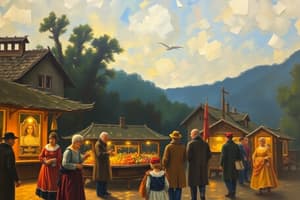Podcast
Questions and Answers
What is a Traditional Economy?
What is a Traditional Economy?
- An economic system that focuses on advanced goods production
- An economic system that encourages individual initiative
- An economic system based on technology
- An economic system where past customs determine how questions are answered (correct)
Which of the following is an example of a Traditional Economy?
Which of the following is an example of a Traditional Economy?
- Native American tribes
- Feudal society
- Caste system
- All of the above (correct)
Where are Traditional Economies typically found?
Where are Traditional Economies typically found?
In rural or poor agricultural nations due to lack of technology.
What influences the decision on what to produce in a Traditional Economy?
What influences the decision on what to produce in a Traditional Economy?
How is production carried out in a Traditional Economy?
How is production carried out in a Traditional Economy?
Who typically receives goods in a Traditional Economy?
Who typically receives goods in a Traditional Economy?
How much is produced in a Traditional Economy?
How much is produced in a Traditional Economy?
What are some advantages of a Traditional Economy?
What are some advantages of a Traditional Economy?
What are some disadvantages of a Traditional Economy?
What are some disadvantages of a Traditional Economy?
What are the characteristics of a Traditional Economy?
What are the characteristics of a Traditional Economy?
Flashcards are hidden until you start studying
Study Notes
Traditional Economy Overview
- Economic system defined by reliance on historical customs to address fundamental economic questions.
- Decisions regarding production, distribution, and consumption are guided by traditions and societal norms.
Examples of Traditional Economies
- Found in various cultural contexts: Native American tribes, feudal societies, caste systems, and among the Amish.
Geographic Distribution
- Mainly located in rural or impoverished agricultural nations, where technology and modern infrastructure are limited.
Production Decisions
- What to produce is influenced by the basic needs of individuals, families, social classes, and established customs.
- The community's needs often dictate the types of goods produced.
Production Methods
- Production techniques are typically passed down through generations, ensuring continuity but reducing innovation.
Distribution of Goods
- Allocation of goods is determined by societal rank, decisions made by elders, producers’ discretion, and traditional practices.
- Lower social classes often receive minimal resources compared to higher classes.
Production Quantity
- Economies typically produce just enough to meet survival needs, following a subsistence model.
Advantages of Traditional Economies
- Reduced conflict due to limited resources leads to increased cooperation and reliance among community members.
Disadvantages of Traditional Economies
- Individual initiative is often restricted, limiting potential production of advanced goods and slowing technological advancement and economic growth.
Key Characteristics
- Economies are simple, primarily agrarian, family-oriented, and exhibit a reluctance to change or adopt new practices.
- Limited economic choices result from adherence to traditional values and customs.
Studying That Suits You
Use AI to generate personalized quizzes and flashcards to suit your learning preferences.




